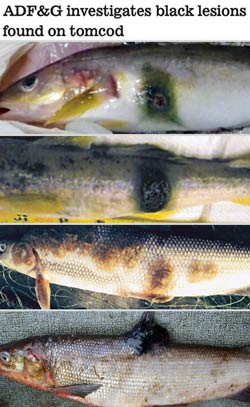


|
 |
|
|
#1 |
|
Registered Member
 Join Date: Mar 2010
Location: Calabasas, CA
Posts: 1,501
|
Diagnosis/treatment for black lesion on anthias
Can anybody diagnose these black lesions on a Ventralis anthias I received today? Any suggestions for treatment? She is in QT with three others I received at the same time. All are acting normally -- slightly stressed and hiding but swimming normally. I gave her a 5 minute freshwater dip to rule out flukes. Nothing dropped off of her. The supplier reports that the lesions were not on the fish when she was bagged yesterday and speculates that it may be an injury sustained in catching her. I doubt that because the color is so dark.

__________________
Current tank: 340g AGE peninsula |
|
|

|
|
|
#2 |
|
Registered Member
 Join Date: Mar 2010
Location: Calabasas, CA
Posts: 1,501
|
The fish died the following day. A second anthias now has a small dark spot under the skin on his snout. She is not eating well. The other two anthias are, so I think she is being affected by whatever is causing the lesion. I am treating with Prazi, but nothing else.
__________________
Current tank: 340g AGE peninsula |
|
|

|
|
|
#3 |
|
Registered Member
Join Date: Jan 2015
Location: Long Island, NY
Posts: 244
|
I'm sorry you can't find an answer, it's very frustrating to see them dwindle away. Beautiful fish, good luck!
|
|
|

|
|
|
#4 |
|
Registered Member
Join Date: Jan 2015
Location: Fremont, CA
Posts: 9,555
|
I've never seen something like this but from the color it could be fungal.
Where did you get the fish from? If mail-order I would contact them ASAP and ask for a refund. They clearly sent you an already visibly sick fish.
__________________
Pairs: 4 percula, 3 P. kauderni, 3 D. excisus, 1 ea of P. diacanthus, S. splendidus, C. altivelis O. rosenblatti, D. janssi, S. yasha & a Gramma loreto trio 3 P. diacanthus. 2 C. starcki Current Tank Info: 200 gal 4 tank system (40x28x24 + 40B + 40B sump tank + 20g refugium) + 30x18x18 mixed reef + 20g East Pacific biotop + 20g FW +... |
|
|

|
|
|
#5 |
|
Registered Member
 Join Date: Mar 2010
Location: Calabasas, CA
Posts: 1,501
|
The color does suggest fungal, but does fungus grow deep in tissue? I am in contact with the vendor and they are responsive . I have been promised a replacement for each on that dies with these symptoms .
__________________
Current tank: 340g AGE peninsula |
|
|

|
|
|
#6 |
|
Registered Member
Join Date: Jan 2015
Location: Fremont, CA
Posts: 9,555
|
Yes, fungal infections can grow internally.
One of the nastiest fungal infections occurs only internally and is almost impossible to cure: Ichthyosporidium hoferi That anthias looked like it had something like a Saprolegnia sp. infection. This is one of those cases where it could make sense to send the fish to a lab for proper ID.
__________________
Pairs: 4 percula, 3 P. kauderni, 3 D. excisus, 1 ea of P. diacanthus, S. splendidus, C. altivelis O. rosenblatti, D. janssi, S. yasha & a Gramma loreto trio 3 P. diacanthus. 2 C. starcki Current Tank Info: 200 gal 4 tank system (40x28x24 + 40B + 40B sump tank + 20g refugium) + 30x18x18 mixed reef + 20g East Pacific biotop + 20g FW +... |
|
|

|
|
|
#7 |
|
Registered Member
 Join Date: Mar 2010
Location: Calabasas, CA
Posts: 1,501
|
I appreciate your help. I did some research on Saprolegni and Ichthyosporidium hoferi they both appear to be freshwater fungus. After reading it, I think I'll transfer the uninfected fish to a new QT and try some anti fungal treatments on the single anthias that has a lesion. I'm not confident the fish will make it through the day since it hasn't eaten in almost a week, but its worth a shot. I did freeze the carcass of the anthias that died so I could send it out to a lab, but I'm not sure I want to incur the cost. I'll offer it to the supplier since he may have a pathogen in his tanks that he should know more about.
__________________
Current tank: 340g AGE peninsula |
|
|

|
|
|
#8 | |
|
Registered Member
Join Date: Jan 2015
Location: Fremont, CA
Posts: 9,555
|
I found some hints on what it could have been:
Mysterious deadly black fungus being found on fish in Pacific Northwest – Gov’t: There was some concern Fukushima radiation could be involved – Many reports of unusual rotting sores, growths, bumps, cancer  That turned out to be a fungus and looks quite similar to what the Anthias had. Here is another thread with very similar looking lesions: What kind of fish disease is this and what to do? BTW: Fungal diseases are absolutely not uncommon in marine fish: Quote:
__________________
Pairs: 4 percula, 3 P. kauderni, 3 D. excisus, 1 ea of P. diacanthus, S. splendidus, C. altivelis O. rosenblatti, D. janssi, S. yasha & a Gramma loreto trio 3 P. diacanthus. 2 C. starcki Current Tank Info: 200 gal 4 tank system (40x28x24 + 40B + 40B sump tank + 20g refugium) + 30x18x18 mixed reef + 20g East Pacific biotop + 20g FW +... |
|
|
|

|
 |
|
|